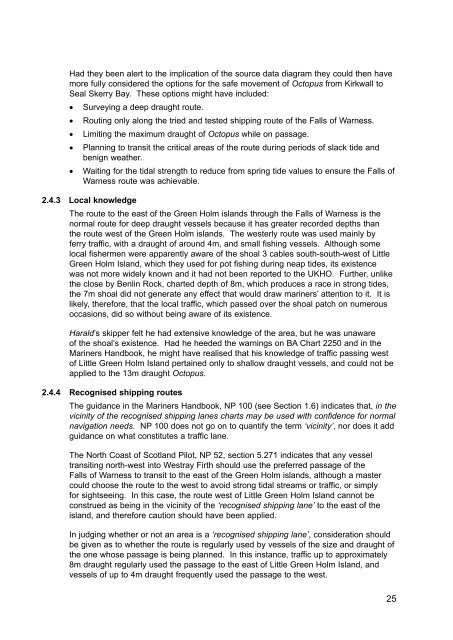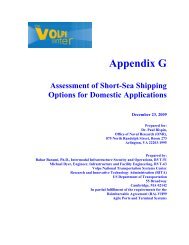Octopus Harald - Marine Accident Investigation Branch
Octopus Harald - Marine Accident Investigation Branch
Octopus Harald - Marine Accident Investigation Branch
Create successful ePaper yourself
Turn your PDF publications into a flip-book with our unique Google optimized e-Paper software.
Had they been alert to the implication of the source data diagram they could then havemore fully considered the options for the safe movement of <strong>Octopus</strong> from Kirkwall toSeal Skerry Bay. These options might have included:• Surveying a deep draught route.• Routing only along the tried and tested shipping route of the Falls of Warness.• Limiting the maximum draught of <strong>Octopus</strong> while on passage.• Planning to transit the critical areas of the route during periods of slack tide andbenign weather.• Waiting for the tidal strength to reduce from spring tide values to ensure the Falls ofWarness route was achievable.2.4.3 Local knowledgeThe route to the east of the Green Holm islands through the Falls of Warness is thenormal route for deep draught vessels because it has greater recorded depths thanthe route west of the Green Holm islands. The westerly route was used mainly byferry traffic, with a draught of around 4m, and small fishing vessels. Although somelocal fishermen were apparently aware of the shoal 3 cables south-south-west of LittleGreen Holm Island, which they used for pot fishing during neap tides, its existencewas not more widely known and it had not been reported to the UKHO. Further, unlikethe close by Benlin Rock, charted depth of 8m, which produces a race in strong tides,the 7m shoal did not generate any effect that would draw mariners’ attention to it. It islikely, therefore, that the local traffic, which passed over the shoal patch on numerousoccasions, did so without being aware of its existence.<strong>Harald</strong>’s skipper felt he had extensive knowledge of the area, but he was unawareof the shoal’s existence. Had he heeded the warnings on BA Chart 2250 and in the<strong>Marine</strong>rs Handbook, he might have realised that his knowledge of traffic passing westof Little Green Holm Island pertained only to shallow draught vessels, and could not beapplied to the 13m draught <strong>Octopus</strong>.2.4.4 Recognised shipping routesThe guidance in the <strong>Marine</strong>rs Handbook, NP 100 (see Section 1.6) indicates that, in thevicinity of the recognised shipping lanes charts may be used with confidence for normalnavigation needs. NP 100 does not go on to quantify the term ‘vicinity’, nor does it addguidance on what constitutes a traffic lane.The North Coast of Scotland Pilot, NP 52, section 5.271 indicates that any vesseltransiting north-west into Westray Firth should use the preferred passage of theFalls of Warness to transit to the east of the Green Holm islands, although a mastercould choose the route to the west to avoid strong tidal streams or traffic, or simplyfor sightseeing. In this case, the route west of Little Green Holm Island cannot beconstrued as being in the vicinity of the ‘recognised shipping lane’ to the east of theisland, and therefore caution should have been applied.In judging whether or not an area is a ‘recognised shipping lane’, consideration shouldbe given as to whether the route is regularly used by vessels of the size and draught ofthe one whose passage is being planned. In this instance, traffic up to approximately8m draught regularly used the passage to the east of Little Green Holm Island, andvessels of up to 4m draught frequently used the passage to the west.25
















